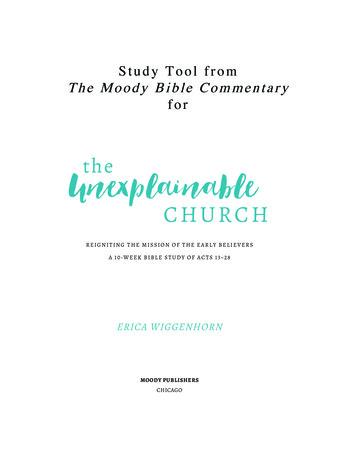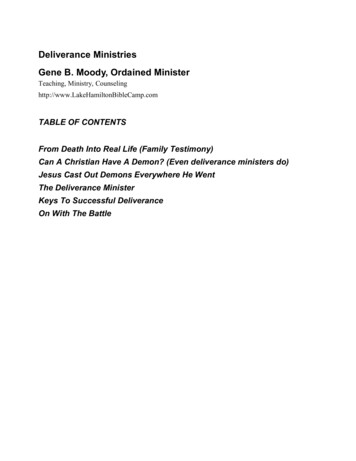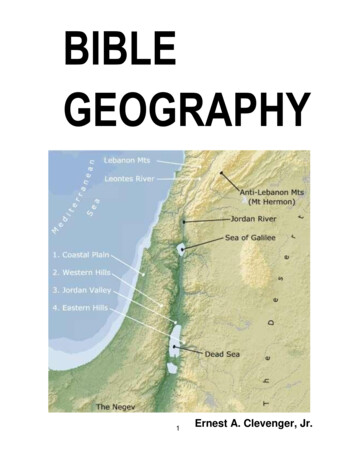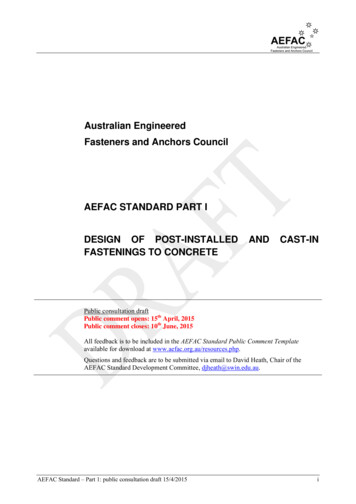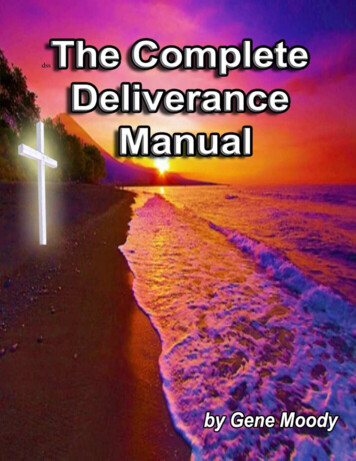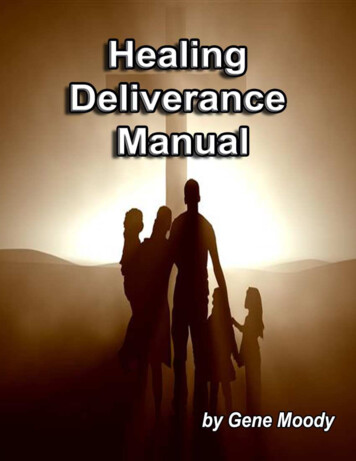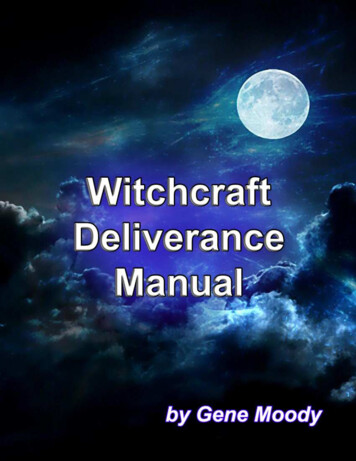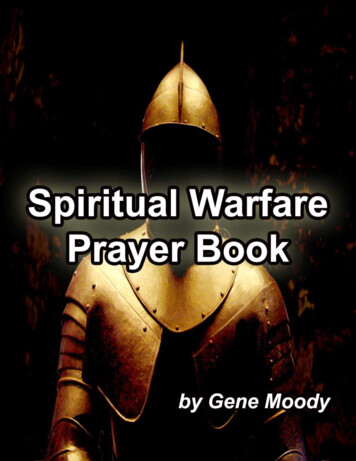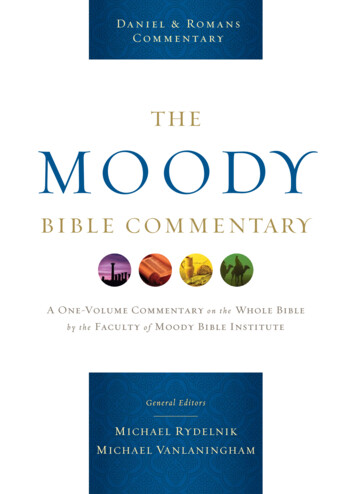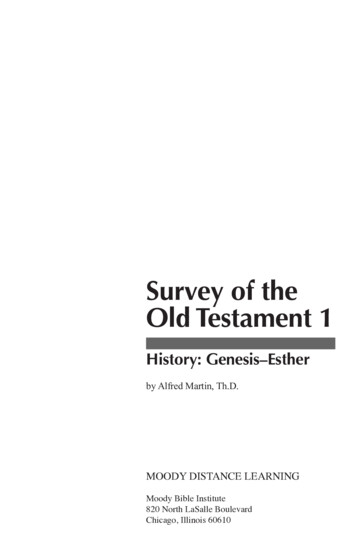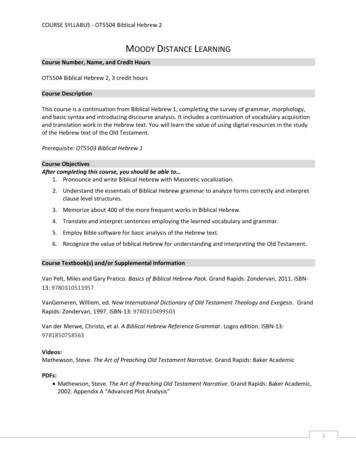
Transcription
COURSE SYLLABUS - OT5504 Biblical Hebrew 2MOODY DISTANCE LEARNINGCourse Number, Name, and Credit HoursOT5504 Biblical Hebrew 2, 3 credit hoursCourse DescriptionThis course is a continuation from Biblical Hebrew 1, completing the survey of grammar, morphology,and basic syntax and introducing discourse analysis. It includes a continuation of vocabulary acquisitionand translation work in the Hebrew text. You will learn the value of using digital resources in the studyof the Hebrew text of the Old Testament.Prerequisite: OT5503 Biblical Hebrew 1Course ObjectivesAfter completing this course, you should be able to 1. Pronounce and write Biblical Hebrew with Masoretic vocalization.2. Understand the essentials of Biblical Hebrew grammar to analyze forms correctly and interpretclause level structures.3. Memorize about 400 of the more frequent works in Biblical Hebrew.4. Translate and interpret sentences employing the learned vocabulary and grammar.5. Employ Bible software for basic analysis of the Hebrew text.6. Recognize the value of biblical Hebrew for understanding and interpreting the Old Testament.Course Textbook(s) and/or Supplemental InformationVan Pelt, Miles and Gary Pratico. Basics of Biblical Hebrew Pack. Grand Rapids: Zondervan, 2011. ISBN13: 9780310513957VanGemeren, Williem, ed. New International Dictionary of Old Testament Theology and Exegesis. GrandRapids: Zondervan, 1997. ISBN-13: 9780310499503Van der Merwe, Christo, et al. A Biblical Hebrew Reference Grammar. Logos edition. ISBN-13:9781850758563Videos:Mathewson, Steve. The Art of Preaching Old Testament Narrative. Grand Rapids: Baker AcademicPDFs: Mathewson, Steve. The Art of Preaching Old Testament Narrative. Grand Rapids: Baker Academic,2002. Appendix A “Advanced Plot Analysis”1
COURSE SYLLABUS - OT5504 Biblical Hebrew 2 Waard, Jan de, and Eugene Albert Nida. A Translator’s Handbook on the Book of Ruth. 2nd ed. UBSHandbook Series. New York: United Bible Societies, 1991. Section on Ruth 1 Waard, Jan de, and Eugene Albert Nida. A Translator’s Handbook on the Book of Ruth. 2nd ed. UBSHandbook Series. New York: United Bible Societies, 1991. Section on Ruth 2.Supplemental Bibliography (Recommended for Future Study, but Not Required): Arnold, Bill, and John Choi. A Guide to Biblical Hebrew Syntax. Cambridge: Cambridge UniversityPress, 2003. Dobson, John H. Learn Biblical Hebrew. Winona Lake, IN: Eisenbrauns, 1999. Kelley, Page H. Biblical Hebrew: An Introductory Grammar. Grand Rapids, MI: Eerdmans, 1992. Kittel, Bonnie. Biblical Hebrew: A Text and Workbook. 2nd Edition. New Haven, CT: Yale, 2005. Lambdin, Thomas O. Introduction to Biblical Hebrew. New York: Scribner, 1971. Rocine, B. M. Learning Biblical Hebrew: A New Approach Using Discourse Analysis. Macon, GA.:Smyth & Helwys. 2000. Ross, Alan. Introducing Biblical Hebrew. Grand Rapids, MI: Baker, 2001. Futato, Mark D. Beginning Biblical Hebrew. Winona Lake, IN: Eisenbrauns, 2003. Weingreen, J. A Practical Grammar for Classical Hebrew. 2nd ed. New York: Oxford UniversityPress, 1959. Gesenius, Wilhelm, Gesenius’ Hebrew Grammar. 2nd ed. by E. Kautzsch and translated by A.E.Cowley. Oxford: Clarendon, 1910. Joüon, Paul. A Grammar of Biblical Hebrew. [2d corrected edition.] 2 vols. Subsidia biblica, no.14/I-II. Translated and revised by T. Muraoka. Rome: Pontifical Biblical Institute. 1996. Van der Merwe, Christo H.J., Jackie A. Naude and Jan H. Kroeze, A Biblical Hebrew ReferenceGrammar, Sheffield, 2000. Waltke, Bruce K. and O'Connor, M., An Introduction to Biblical Hebrew Syntax. Winona Lake:Eisenbrauns, 1990. Williams, R. J., Hebrew Syntax: An Outline, second edition. Toronto: University of Toronto Press,1976. Brown, Francis;. Driver, S. R and. Briggs, C. A . A Hebrew and English Lexicon of the OldTestament. (BDB) Oxford University Press, 1907; reprint, Hendrickson Publishers, 1995. Clines, David J. A (ed.), The Dictionary of Classical Hebrew. Sheffield, England, 2011. Koehler, Ludwig & Baumgartner, Walter. The Hebrew and Aramaic Lexicon of the Old Testament.5 vols. Leiden: E.J. Brill, 1994. Botterweck, G. Johannes; Ringgren, Helmer; Fabry, Heinz-Josef, eds., Theological Dictionary ofthe Old Testament, vols. 1-14 available, translated by David E. Green, Grand Rapids: Eerdmans,1974-2004. Harris, R. Laird; Archer, Gleason and Waltke, Bruce. Theological Wordbook of the Old Testament.2 volumes. Chicago: Moody Press, 1980. Jenni, Ernst. Theological Lexicon of the Old Testament. 3 vols. Peabody: Hendrickson Publishers,1997. VanGemeren, Willem. Editor The New International Dictionary of Old Testament Theology andExegesis. 5 volumes. Grand Rapids: Zondervan, 1997. Kelley, Page H.; Mynatt, Daniel S. and Crawford, Timothy G. The Masorah of Biblia HebraicaStuttgartensia: Introduction and Glossary. Grand Rapids: Eerdmans, 1998.2
COURSE SYLLABUS - OT5504 Biblical Hebrew 2 Chisholm, Robert B. Jr., From Exegesis to Exposition: A Practical Guide to Using Biblical Hebrew.Grand Rapids: Baker, 1998.Wegner, Paul. Using Old Testament Hebrew in Preaching: A Guide for Students and Pastors.Grand Rapids: Kregel, 2009.Wegner, Paul. A Student’s Guide to Textual Criticism of the Bible: Its History, Methods andResults. Downers Grove: IVP Academic, 2006.Cook, John and Robert Holmstedt. Beginning Biblical Hebrew. Grand Rapids: Baker, 2013.Garret, Duane and Jason DeRouchie. A Modern Grammar for Biblical Hebrew. Nashville: B&H,2009.AssignmentsGuideline for the Discussion Board: Post your initial response to the discussion question by mid-week(Friday, 11:59pm CT). Then read and respond to at least ONE of your classmates’ initial posts by the endof the week (Monday, 11:59pm CT).Readings: Read the assigned material in Pratico and Van Pelt, Basics of Biblical Hebrew: Grammar. Readthe material at the beginning of the week and review it often after the video lectures and during thehomework. We will not focus on material in the Advanced Information section, or the Exegesis section.Video Lectures: Listen to Van Pelt, Basics of Biblical Hebrew: Video Lectures. Review the lectures asneeded and focus on the material stressed in the lecture.Tutorials: Listen to Cook, Supplemental Material. These short screen captures will illustrate the properuse of Logos Bible Software, the basics of Hebrew exegesis, and the use of Hebrew in ministry. This issupplemental motivational and informational material that is not included in the weekly quiz.Vocabulary and Grammar Memorization: Learn the vocabulary and grammar presented in Van Pelt,Basics of Biblical Hebrew: Grammar. This is a challenging and necessary assignment. Please takemultiple short periods of time throughout the week to master the vocabulary of the chapter and thevarious forms presented throughout the text.Discussion Board: Each student will be assigned a different translation exercise from the workbook.After an initial study of the material, you are required to post your translation of the assignedexercise along with a detailed explanation of the process you used to complete the translation.Special attention should be given to the new material presented in the chapter. The explanationshould be similar to that given by the professor in his weekly Parsing and Translation video. Theinitial post is due by 11:59 CT on Friday. You are then required to comment on at least one postfrom a classmate. This final post is due by 11:59 CT on Monday. Early posts are encouraged. Thisdiscussion will simulate group work that might take place in class or in informal gatherings.Workbook Exercises: Once you have a basic grasp of the grammar and vocabulary, complete all theassigned workbook exercises. As you complete the workbook, you may refer to the textbook and theinformation window in Logos (Do not use an English translation or an answer key for this assignment).3
COURSE SYLLABUS - OT5504 Biblical Hebrew 2This will be considered an act of plagiarism. Each lesson also includes a video that illustrates a parsingand translation exercise. The workbook needs to be submitted by Monday at 11:59pm each week. Scanyour hard copy of the workbook, save it in your computer, and attach the document into theappropriate assignment area in Blackboard. An answer key will also be posted for your review after thedeadline. If you are late in your assignment, please do not access the answer key until after you havesubmitted your workbook. The workbook assignments are reviewed for completeness, correctness andtimeliness. They are graded on a pass/fail basis.Pronunciation: As you work through the homework exercises, pronounce the Hebrew text for each ofthe assignments. Follow the pronunciation guide given during the first lesson. Each week you will beasked to pronounce a brief reading of a section of the Hebrew Old Testament through the VideoEverywhere feature in Blackboard.Translation: In Weeks 10 and 12, you are required to translate a chapter of the Hebrew Bible. Thisassignment is comprised of the following requirement: translate the chapter utilizing only your LexhamHebrew Bible and Lexicons. You may not use another English translation. After you translate thechapter, you may read the PDF from the UBS Translators Handbook to help you think through sometranslational issues.AssessmentsAssessmentsPronunciation (13 Posts)Workbook Exercises and Translations (11 Exercises and 2Translations)Discussion Board (13 Posts)Quizzes (13)Final ExamTotal:% of Total10%20%10%40%20%100%Letter grades are determined by the following scale:LetterGradeAAB PercentageEquivalent96 – 10094 – 9592 – 93DescriptionExceptional workExcellent workVery good work4
COURSE SYLLABUS - OT5504 Biblical Hebrew 2BBC CCF89 – 9187 – 8883 – 8679 – 8275 – 78 75Good workAbove average workAverage workWork needs improvementMinimally acceptable workUnacceptable workCourse ResourcesOnline students have access to the Moody Library. Go through this Checklist to determine how best toobtain books and articles on your topic: ist Bookmark the library’s search start page for MBI-DL: ur-search/Bookmark this online guide for MBI-DL students: k this tab that provides tutorials for online ng/tutorialsIn addition to the resources available at the Moody Library, you may wish to visithttp://www.biblicalstudies.org.uk or www.bible.org. These sites contain content on various topicswritten by competent biblical scholars. It is also suggested that you download a free version of the NETBible at http://bible.org.The final resource that deserves mention here is iTunes University. Apple has developed a platform forcolleges and universities to post audio and video content. There are a number of lectures available oniTunes U. Download the iTunes University application for your device or computer to access.Course Copyright StatementCopyright 2016 by The Moody Bible Institute of Chicago. All rights reserved.Unless otherwise specified, the materials and services on this website are for your personal and noncommercial use, and you may not modify, copy, distribute, transmit, display, perform, reproduce,publish, license, create derivative works from, transfer, or sell any information, software, products orservices obtained from the website without the written permission from Moody Distance Learning,Moody Bible Institute, 820 N. LaSalle Blvd., Chicago, Illinois 60610.5
Jan 26, 2016 · 1. Pronounce and write Biblical Hebrew with Masoretic vocalization. 2. Understand the essentials of Biblical Hebrew grammar to analyze forms correctly and interpret clause level structures. 3. Memorize about 400 of the more frequent works in Biblical Hebrew. 4. Translate and interpret sentences employin
